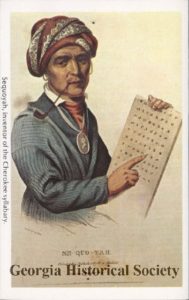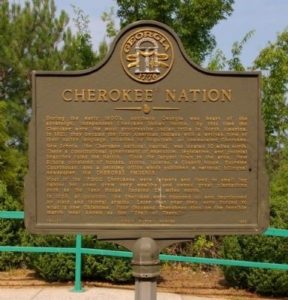In honor of the 2016-2017 Georgia History Festival, “A State of Innovation,” the November #MarkerMonday posts will focus on Sequoyah, the creation of the Cherokee alphabet, and the Cherokee Nation. Over the course of the month, these posts will discuss Sequoyah, his efforts to create a written alphabet for the Cherokee Nation, and the forced removal of the Cherokee from Georgia along the Trail of Tears.
This week’s #MarkerMonday discusses the Cherokee syllabary and its creator, Sequoyah. Born in the Tennessee mountains, Sequoyah resettled in Arkansas when tribal lands along the Little Tennessee River were ceded to white settlers in the 1790s. As a silversmith, Sequoyah’s work brought him in contact with the settlers. Intrigued by the settlers’ Many Cherokees were skeptical of the written word, perceiving the idea as witchcraft. Despite this skepticism, Sequoyah began developing a writing system only to be postponed by the War of 1812. Sequoyah, like many other Cherokee, enlisted with the US Army and fought in the Battle of Tallaschatche and with Andrew Jackson at the Battle of Horseshoe Bend. His time in the army allowed Sequoyah to see the soldier’s writing system in action as he continued to develop his own system.

Sequoyah Postcard Courtesy of Georgia Historical Society, Collection of Postcards, MS 1361-PC-HistoricSite-1
Sequoyah continued his writing project after his discharge in 1814 and marriage to Sally Waters in 1815, resulting in the creation of the Cherokee syllabary. A form of writing in which a symbol represents a syllable instead of a single letter, the completed syllabary consisted of 86 characters. By the mid-1820s, the Cherokee Nation had adopted the syllabary, overcoming initial skepticism about written language. Following the syllabary’s adoption, use of the writing system spread rapidly and high literacy rates were achieved. In 1828, the Cherokee began printing a dual language newspaper, the Cherokee Phoenix, in New Echota, Georgia. Even after the adoption of his syllabary, Sequoyah continued to work to benefit his people by negotiating treaties and aid for displaced Cherokees. Sequoyah died in Mexico in 1840 while attempting to communicate with other Cherokee communities believed to be living in the area. His burial site remains unknown.
Top Image Details from map of Georgia for Sherwood's Gazetteer of Georgia, ca.1830. Courtesy of the Georgia Historical Society Map Collection, MS 1361-MP 079.
Explore the links below to learn more about Sequoyah, the Cherokee syllabary, and the Cherokee Phoenix.
GHS is proud to house pages from a section of pages from a Cherokee Bible, written after 1824 in the Cherokee language.
New Georgia Encyclopedia-Sequoyah
New Georgia Encyclopedia-Cherokee Phoenix
New Georgia Encyclopedia-Cherokee Indians

